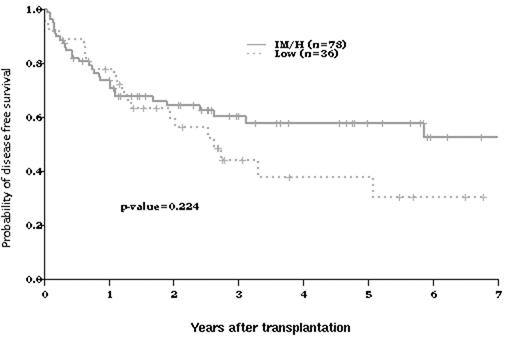Abstract
HDC and AHSCT is an effective treatment option for patients with relapsed or refractory NHL. The outcome of this treatment depends on the histological grade (indolent versus aggressive) with a well documented time dependent difference in temporal relapse pattern. We developed statistical models to describe the time dependent outcome after AHSCT based on histologic grade and other variables. During January 1993 to December 2003, 114 relapsed or refractory NHL patients were treated at single institution using high-dose BCNU 600 mg/m2, etoposide 2400 mg/m2, and cisplatin 200 mg/m2 IV over 5 days and AHSCT. Median age was 53.5 (range: 25–70) years, 78 patients had aggressive NHL and 36 indolent NHL. Immediately before transplant, 75 patients received involved-field radiotherapy (IFR) to sites of prior bulky (> 5 cm) disease. Twenty-seven patients had mobilized stem cell transplant (13 with in vivo purging and 14 with ex-vivo purging). At a median follow up of 33 (range: 3 to 118) months, the estimated 5 year Kaplan-Meier probabilities of overall survival (OS) and DSF were 61% and 51%, respectively. DFS was similar up to about 1.2 years between indolent and aggressive NHL (Figure 1). DFS of the group who had purged stem cells was improved marginally over non-purged group. Cox proportional hazards model was used to adjust for differences in baseline characteristics between grades that might affect DFS. The proportionality assumption of Cox model was tested by adding a time-dependent covariate for each variable. This showed that the proportionality did not hold for lymphoma grade, indicating the relationship between the grade and DFS differed over time. The results of piece-wise Cox model after controlling age, IFR, purging status indicate there was no difference of DFS between the grade groups up to 1.2 years (optimal cut-off point) post-transplantation (p = 0.748). However, the relative risk for experiencing relapse after 1.2 year in patients with indolent compared with patients with aggressive NHL was 4.22 (p = 0.006) with 95% confidence interval (1.5, 11.9). Our results statistically prove the previously described biological differences in outcomes of patients with indolent and aggressive NHL following HDC. The time-dependent effect of lymphoma grade on DFS indicates the need for early (within first year) incorporation of novel therapeutic approaches, such as post-transplant immunotherapy, tandem high-dose therapy and, allogeneic transplant to generate graft-versus-lymphoma effect, in management of patients with indolent NHL undergoing autologous transplantation.
Figure 1: DFS by tumor grade.
Author notes
Corresponding author


This feature is available to Subscribers Only
Sign In or Create an Account Close Modal